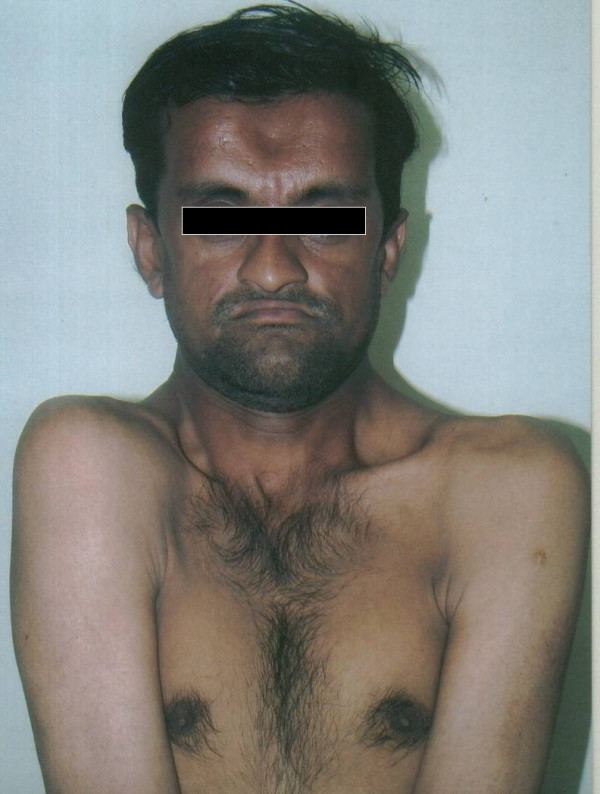ICD-9-CM 755.59 DiseasesDB 30594 | ICD-10 Q74.0 OMIM 119600 | |
 | ||
Synonyms cleidocranial dysplasia, Marie-Sainton syndrome, mutational dysostosis | ||
Cleidocranial dysostosis (CCD), also called cleidocranial dysplasia, is a congenital disorder, that mostly affects the development of bones and teeth. The collarbones are typically either poorly developed or absent, which often allows the shoulders to be brought close together. The front of the skull often does not close until later and those affected are often short. Other symptoms may include a prominent forehead, wide set eyes, abnormal teeth, and a flat nose. Symptoms can vary between people; however, intelligence is typically normal.
Contents
The condition is either inherited from a person's parents or occurs as a new mutation. It is inherited in an autosomal dominant manner. It is due to a defect in the RUNX2 gene which is involved in bone formation. Other conditions that can produce similar symptoms include mandibuloacral dysplasia, pyknodysostosis, osteogenesis imperfecta, and Hajdu-Cheney syndrome.
Treatment includes supportive measures such as a device to protect the skull and dental care. It affects about one per million people. Males and females are equally commonly affected. Modern descriptions of the condition date to at least 1896. The term is from cleido meaning collarbone, cranial meaning head, and dysostosis meaning formation of abnormal bone.
Signs and symptoms
Cleidocranial dysostosis is a general skeletal condition so named from the collarbone (cleido-) and cranium deformities which people with it often have.
People with the condition usually present with a painless swelling in the area of the clavicles at 2–3 years of age. Common features are:
Other features are: parietal bossing, basilar invagination (atlantoaxial impaction), persistent metopic suture, abnormal ear structures with hearing loss, supernumerary ribs, hemivertebrae with spondylosis, small and high scapulae, hypoplasia of illiac bones, absence of the pubic bone, short / absent fibular bones, short / absent radial bones, hypoplastic terminal phalanges.
Genetics
It is usually autosomal dominant, but in some cases the cause is not known. It occurs due to haploinsufficiency caused by mutations in the CBFA1 gene (also called Runx2), located on the short arm of chromosome 6, which encodes transcription factor required for osteoblast differentiation. It results in delayed ossification of midline structures of the body, particularly membranous bone.
A new article reports that the CCD cause is thought to be due to a CBFA1 (core binding factor activity 1) gene defect on the short arm of chromosome 6p21 . CBFA1 is vital for differentiation of stem cells into osteoblasts, so any defect in this gene will cause defects in membranous and endochondral bone formation.
Diagnosis
Different features of the dysostosis are significant. Radiological imaging helps confirm the diagnosis. During gestation (pregnancy), clavicular size can be calculated using available nomograms. Wormian bones can sometimes be observed in the skull.
Treatment
Around 5 years of age, surgical correction may be necessary to prevent any worsening of the deformity. If the mother has dysplasia, caesarian delivery may be necessary. Craniofacial surgery may be necessary to correct skull defects Coxa vara is treated by corrective femoral osteotomies. If there is brachial plexus irritation with pain and numbness, excision of the clavicular fragments can be performed to decompress it. In case of open fontanelle, appropriate headgear may be advised by the orthopedist for protection from injury.
Prognosis
Several studies have reported that life expectancy appears to be normal for people with CCD.
Epidemiology
It affects about one per million people.
Notable cases
At the rescue of Jessica McClure in 1987, Ron Short, a muscular man (a roofing contractor) who was born without collarbones because of cleidocranial dysostosis and so could collapse his shoulders to work in cramped corners, arrived at the site and offered to go down the shaft; they accepted his offer, although did not use it.
Child actor Gaten Matarazzo was born with cleidocranial dysplasia, which is incorporated into his character's storyline on Stranger Things.
